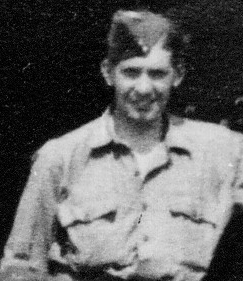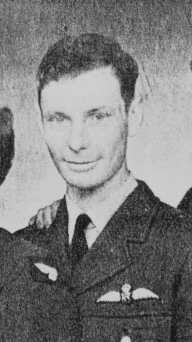Consolidated Liberator, AL577, Jenkinstown, Co. Louth
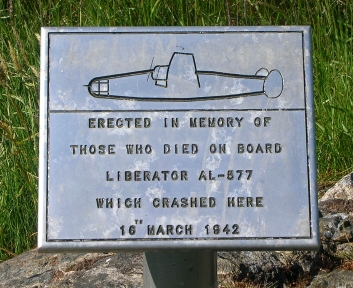 In terms of
loss of life, the worst of the wartime air crashes occurred on
a lonely hill top in County Louth in early 1942. The 16th of
March, 1942 would see the deaths of fifteen young allied
airmen when their bomber crashed in to the mountain named
Slieve na Glogh, which rises up above the townland of
Jenkinstown on the Cooley Peninsula. It was the second of
three fatal wartime crashed in the area, the others being in
1941 and the last in 1944.
In terms of
loss of life, the worst of the wartime air crashes occurred on
a lonely hill top in County Louth in early 1942. The 16th of
March, 1942 would see the deaths of fifteen young allied
airmen when their bomber crashed in to the mountain named
Slieve na Glogh, which rises up above the townland of
Jenkinstown on the Cooley Peninsula. It was the second of
three fatal wartime crashed in the area, the others being in
1941 and the last in 1944.
This area would witness the destruction of three aircraft before the war ended. A British Hudson bomber crashed with three fatalities in 1941 and a P-51 Mustang fighter of the US Army Air Forces crashed in September 1944 killing its pilot.
The story of the aircraft crash has been told many times in a
number of publications and these are listed below.
This photo, posted on social media by a local man, was
apparently taken at the crash site and this is the best copy
available, a snap taken on mobile phone. The view was
explained by local man Derek Roddy as being to the west across
the crash site from Slievenaglogh. The slopes in the
background, Annaloughhan Mountain, are, in 2022, covered with
forestry but the stone wall is a common visible feature on
both. The tail fins of the aircraft appear to be about on
top of the remains of a low stone wall feature which runs
through the middle of the photo. It is along this wall
that the 2022 memorial is located.
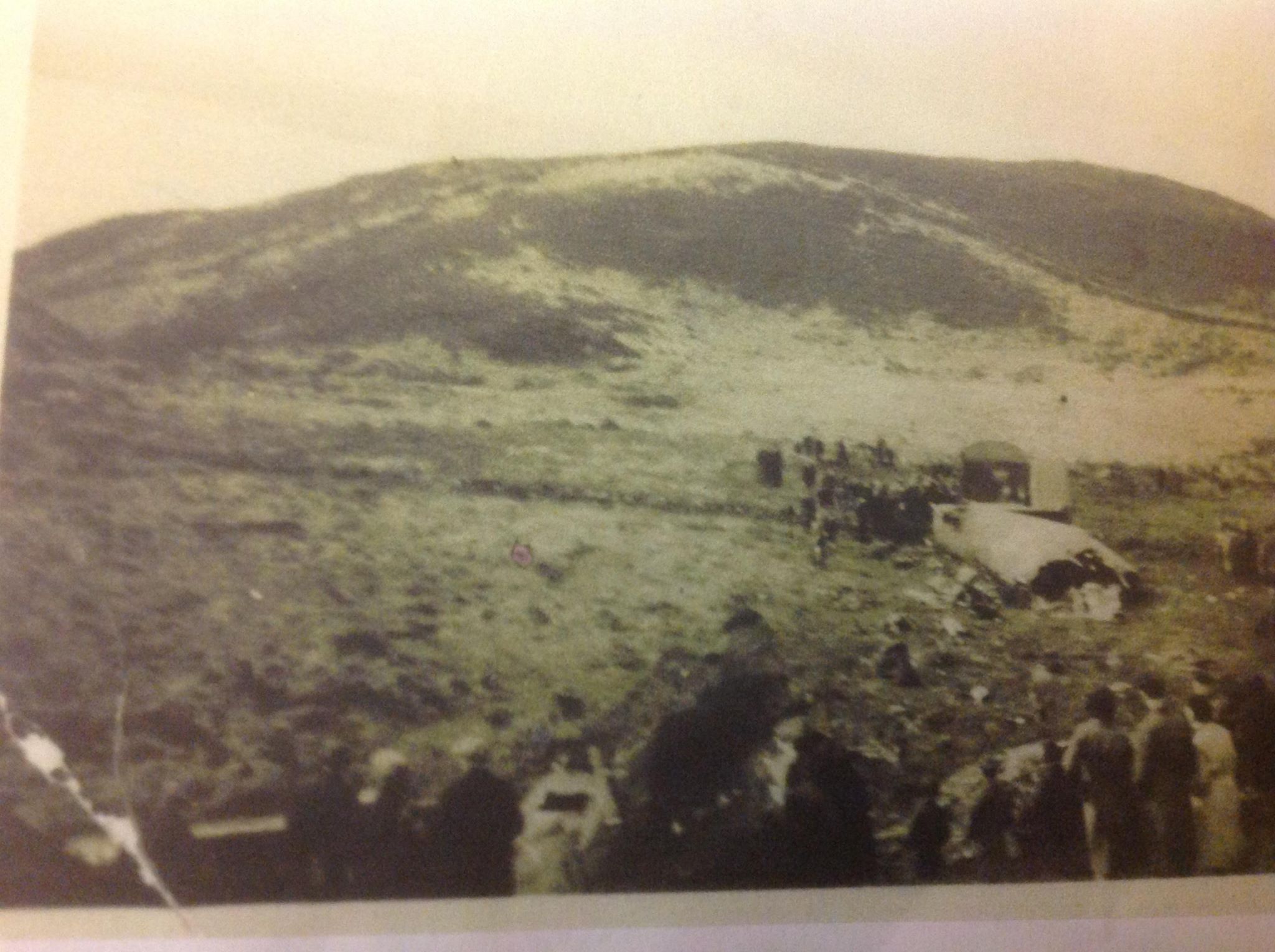
A modern comparison would be the image below taken in May 2022.
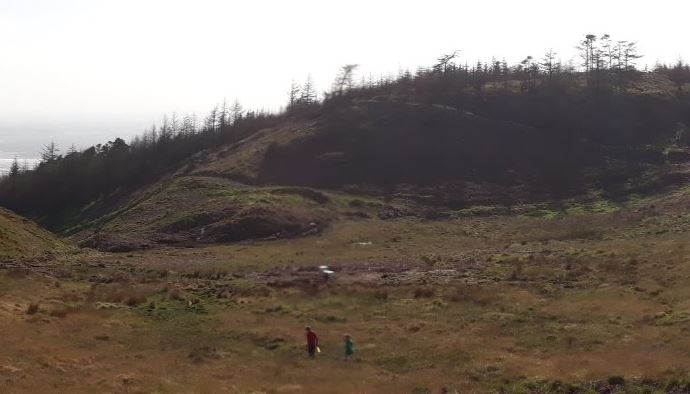
The scene would appear to show the crumpled tail of a Liberator
bomber in the right center of the photo, with one of the rounded
tail planes still attached and visible. A comparison can
be made with this stock image of an early Liberator bomber.
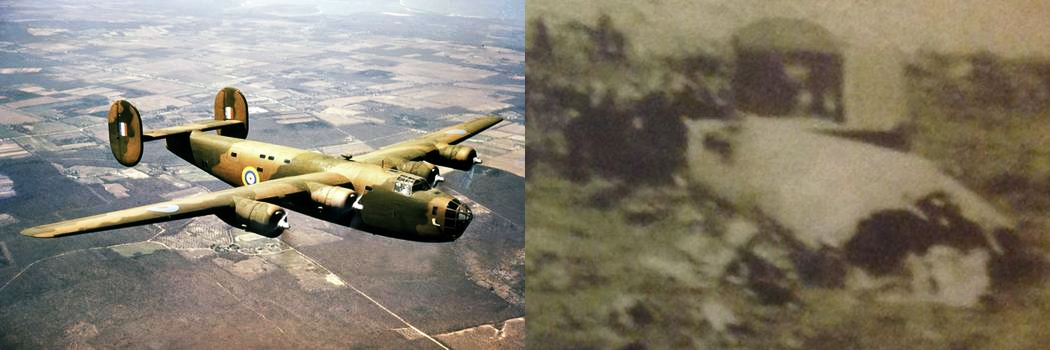
A further set of photos, it seems known only in the local area
until 2022 show the terrible aftermath of the crash and are
testament to the violence of the minutes of Liberator
AL577. These are all copies of scans or photo copies that
Noel Roddy had collected and annotated over the years.
This photo shows wreckage with a landing gear tire and one
landing gear leg. The curved item to the left of the tire
appears to be a broken propeller.
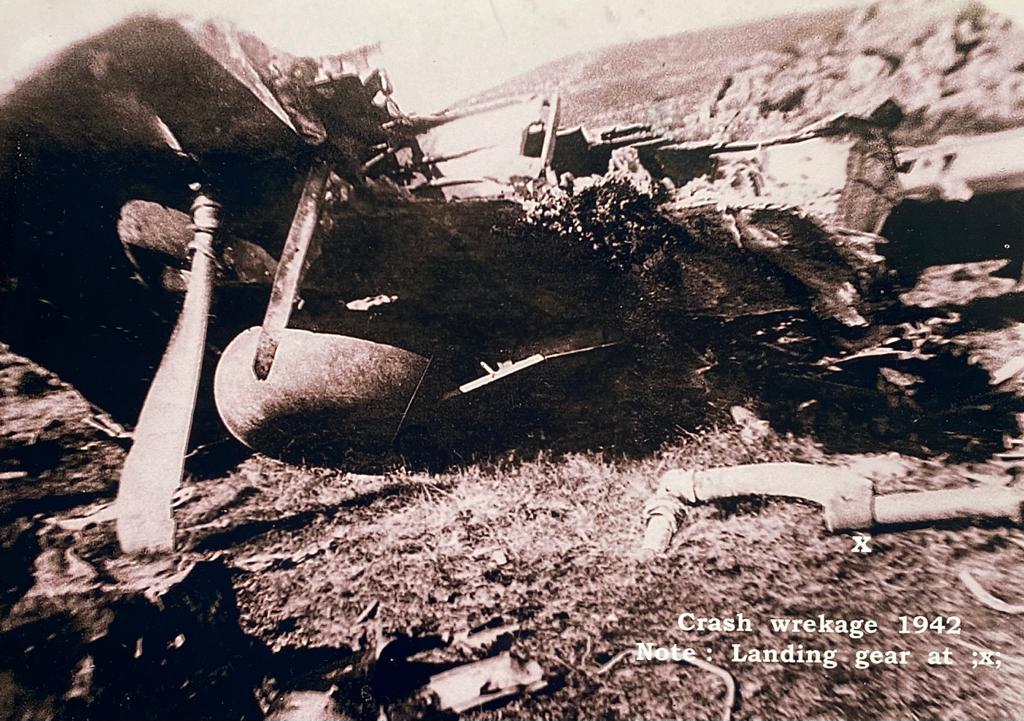
In the image below, the viewer is looking south east across the
crash site with a particular rocky outcrop on the left of the
image. Again, Noel Roddy has labeled the images.
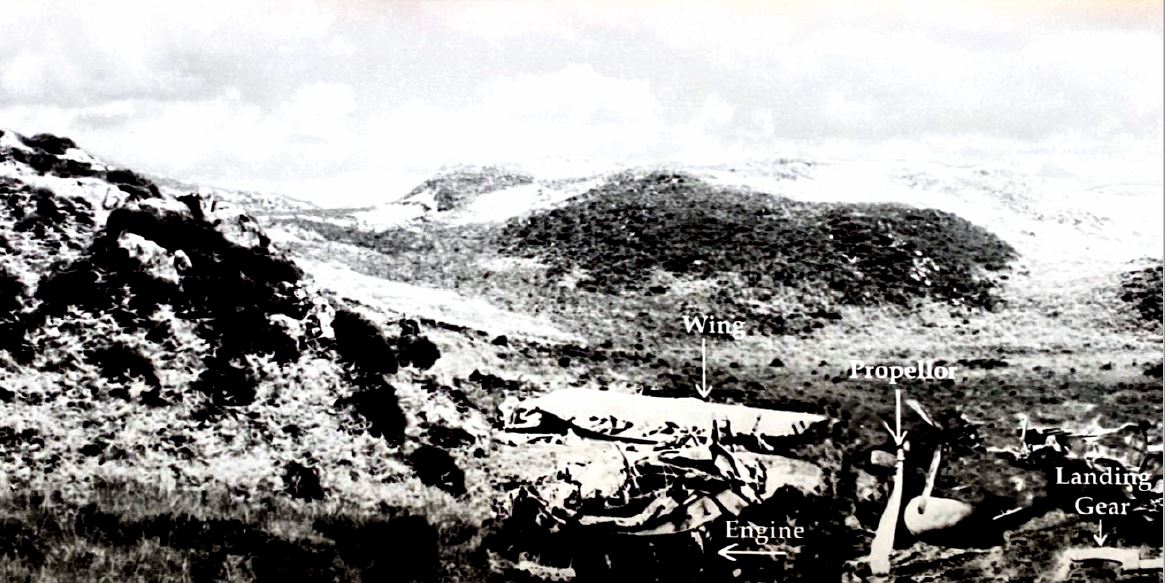
The labeled wing above can be seen in the photo below.
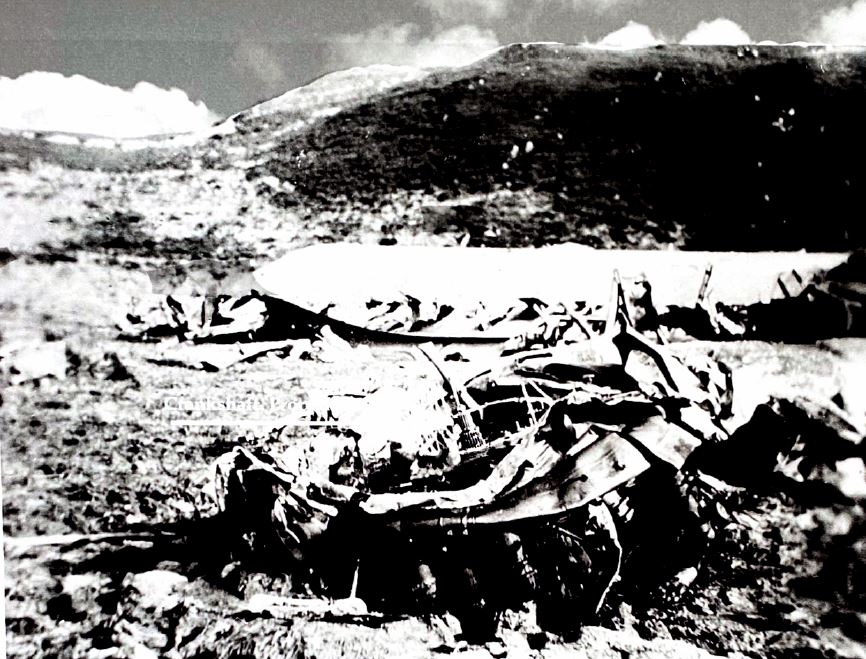
The story of the crash began in the far away deserts of North
Africa in the winter of 1941/1942. During 1941, Royal Air Force
(RAF) 108 Squadron was engaged in bombing missions in support of
the British campaign in North Africa. In December 1941, it was
decided that in the coming months the unit would transition from
the Wellington twin engine bomber to the American built,
Consolidated Liberator. The process of transition is explained
in detail by Andreas Biermann in his 'Crusader
Project' Blog - The first B-24 Liberators in the Desert.
The 108 Squadron diary records the receipt of the first new
Liberator on the 29 Nov 1941 at Fayad. The serial number
is not recorded in the Summary (Form 540) and it is immediately
noted that the aircraft arrived without any form of defensive
gun armament or technical publications. The following 5
December, "The Liberator" is stated to be serviveable and the
training course began. The Details of Work (Form 541)
record this to be AL577, and it flew for the remainder of the
month under the command of Major Cairns, Lt Reynolds and
others, who were members of the US Army Air Forces carrying out
conversion training for the Squadron. Deliveries of
further aircraft are recorded on 9 December, 10 December and 13
December. Again their serials are not recorded but AL574
appears in the Form 541 on the 13th and AL530 on the 19th.
The fourth aircraft was AL566 which went direct to a Maintenance
Unit for fitment of armament. AL577 flew its first bombing
practice flight on 30 December 1941. Upon arrival at the
squadron, the aircraft were assigned an individual aircraft
letter which was painted in large letters aft of the roundel on
the fuselage.
Through out the most of January 1942, AL577 continued to carry
on the training role in the squadron's effort to become fully
serviceable on the type.
Finally, on the night of January 29th, AL577 flew its first
bombing raid, to El Aghelia returning the following afternoon to
the more mundane training role. The Form 540 details
Liberator 'O' being flown by F/Lt Alexander to attack motor
transport on the Agedabia - Aghelia road. Little mention
of AL577 is found in February until the 16th February when it
flew a raid on Benghazi. It again is not mentioned until
21st, 23rd and 27th February when it flew local air tests close
to the base. It might be the case that the unit was no
longer recording all training flights. The identity letter
O is associated with AL574 in February records.
The 1st of March records AL577 being fitted with twin 0.5"
Browning machine guns but noting this was still inadequate.
The aircraft, AL577, this time noted as being aircraft ID
letter N, carried out a special duties flight on the 2 March
1942 to the occupied island of Crete.
Following this introduction into service it was decided that the entire Squadron should convert to the Liberator and it was decided that one of the new aircraft would fly to the United Kingdom with a cadre of experienced 108 Squadron members. There they would collect and prepare new Liberator bombers for ferry to North Africa. This decision is mentioned in the 28 February 1942 ORB. Ahead lay a long and dangerous flight from Egypt, across North Africa to Gibraltar followed by the long over-water flight to England across the Atlantic. As squadron veteran Steve Challen explained in his writings, the Squadron leader and squadron gunnery officers both volunteered to take one of the bombers to England. On board the aircraft were a crew of six men with thirteen more members of the squadron as passengers. These included six pilots, three navigators, three wireless operator/air gunners (W.Op/A.G) and one fitter mechanic. The nineteen men were a mix of English, Scottish, Australian, Canadian and a lone Kiwi.
Sources for research on this crash are many. Primary among
these are the Irish Army Military Archives report dating from
March 1942. The Australian National Archives also have Casualty
files for three of the Australians on board the aircraft. From
one of these files comes this text describing the outline
circumstances of the crash. And the UK national Archives hold
the AIR81/12771 casualty file for the men of AL577. In
that is a four page report from RAF Northern Ireland
Headquarters dated 25th March 1942 and detailing the events of
the preceding days, the disposition of the dead and wounded and
burial of the wounded in Belfast on the 21st of March.
REPORT ON FLYING ACCIDENT -
LIBERATOR A.L. 577 - 16th March, 1942.
From the information available and action taken at this
Headquarters, the following report is submitted on the above
accident :-
1. The aircraft, LIBERATOR A.L.577, belonging to No. 108
Squadron, Headquarters, Middle East, took off from Egypt on
15-3-42 in transit to the United Kingdom, intending to land
at R.A.F. Station, Hurn, near Christchurch, Bournemouth,
lost its bearings and crashed near Jenkinstown, Dundalk,
Eire, (map reference IJ.1408) at approximately 14.10 hours
on 16.3.42. It is understood from Accidents, Gloucester,
that during the early part of the flight the aircraft
acknowledged orders to return to Egypt owing to the bad
weather conditions prevailing over the British Isles at that time. The
aircraft was West of its course and crashed into high ground. As the accident occurred in Eire and
the evidence available suggested that the cause was due to
disobedience of orders and bad navigation, it was considered
by Accidents, Gloucester, that no useful purpose would be
served by ordering an investigation.
There were 19 occupants in the aircraft, the particulars of whom have now
been confirmed by a survivor. As a result
of the accident, 15 were killed and 4 injured.
2. The injured were admitted to Dundalk Hospital, Eire, and
as their progress permitted, they were transferred over the
Eire border to Daisy Hill Hospital, Newry, and those whose
condition permitted of further travel, were eventually
conveyed to Stranmillis Military Hospital, Belfast,
Arrangements were made for the conveyance of all the
deceased from the scene of the accident to the mortuary at
Messrs. Melville & Co., Funeral Furnishers, Townsend
Street, Belfast. Full details and a summary of the action
taken are given below:-
The report concluded with the following description of the
funeral:
A mass funeral of the under-mentioned took place on
Saturday, 21st March, 1942, from the mortuary at Messrs.
Melville & Co., Townsend Street, Belfast, for interment
in the Belfast City Cemetery, and Service honours were
accorded ;-
F/Lt. Francis Charles BARRATT, D.F.C. (77959).
Crew.
R.62738 F/Sgt. GOODENOUGH, Carlton Stokes.
Passenger.
R.63939 Sgt. KING, Beorge Frederick.
Passenger.
Aus. 402677 Sgt. SLOMAN, Herbert William Thornley.
Passenger.
Pilot at time of Crash - Aus. 402429 Sgt.
WILLIAMS, Lindsay Ross.
4. W/Cdr. R.G.E. Catt, Officer Commanding, R.A.F. Station,
Belfast, was in charge of the funeral party which comprised
4 Officers, one Warrant Officer, 5 senior N.C.Os. and 56
airmen acted as pall bearers.
5. The funeral cortege moved off from Messrs. Melville at
15.00 hours and the 5 coffins draped with the Union Jacks,
were borne by the pall bearers. The cortege was
received at the gates of the City Cemetery by W/Cdr. P.
Murgatroyd, representing the Air Officer Commanding, Royal
Air Force in Northern Ireland, the Reverend W. E. Woosnam
Jones, and the Reverend W.Chestnutt,M.A., the officiating
chaplains. At the conclusion of the
burial service, the last post was sounded,
The history of the flight and crash of AL577 was researched
after the war by a former comrade of the men, Steve Challen, who
as F/Sgt Grenfell Stephen William Challen 937815, flew with many
of the men who came down on AL577 in Louth. Steve Challen died
in 2004 but not before he attempted to contact the survivors of
the crash, T E 'Pat' Pattison, S F Hayden and J R Anderson. He
also contacted many of the relatives of the dead men, including
the sister of Paul Morey who provided copies of the information
Steve had collected. Steve Challen wrote an article about the
brief use of Liberators by 108 Squadron in Flypast magazine in
1998. In this he reported:
worsening weather en route. It was
estimated that they were approaching the point of
no return. Coupled with this news, the Bendix radio
was reported unserviceable — despite the efforts of all the
wireless operators on board they were unable to find the
fault. Sgt Gibbons had the most Bendix experience — having
gained it on the Sumatra trip. While attempts were in hand
to restore communications, discussions took place on the
flight deck on whether or not to continue. The consensus of
opinion, including that of the passengers, was to fly
on.
Much later they found themselves above 10/10 cloud
which continued long past their ETA (estimated time of
arrival) at Hurn in Dorset. Everyone was warned to
prepare for a possible ditching. Descending slowly through
the cloud, a glow was seen which could only be the lights of
a town or city in neutral Eire. The size and brightness of
this illumination convinced WgCdr Wells that It was Dublin.
Rather than risk internment in Eire, he altered course for
Aldergrove in Northern Ireland, failing to allow for high
ground on their track. The fuel situation was now becoming
serious.
Articles were written about the crash by Lt Col N C
Harrington, Irish Army, Michael O'Reilly from Meath, Tony Kearns
of Dublin, Patrick Cummins of Waterford and also appeared in
books by John Quinn and David Earl.
The late Irish researcher Tony Kearns summarized the aircraft
movements over the east coast as recorded by the Irish
Army: The Liberator appears to
have crossed the coast at Dublin where it first observed
lights. The military post at the Bull Wall reported an
aircraft at 0630 hrs. moving northeast. It passed over
Sutton less than a minute later. The search-light post at
Howth also reported the aircraft, but its course was
uncertain due to the strong winds. After heading up
the coast to Donabate its track was lost at this time
and no more observations were made until 0735 when it was
reported over the military post at Dundalk. The weather that
morning was overcast with poor visibility and strong
southerly winds making it difficult to even hear the
aircraft from some of the observation locations.
First hand testimony of the flights events survive from at
least two of the survivors, from letters they wrote to the next
of kin of their comrades and later after the war to Mr. Challen.
Sgt Pattison wrote to tell the father of Sgt. Morey:
We left Egypt on March 15th in a
Liberator (giant American four engined bomber); there were
nineteen of us together with full kit on board.
Our mission to England was a special one, we were not
coming back to stay. The nineteen fellows consisted of the
ships crew of which your son was navigator and three
specially selected crews, with one flight engineer. We left
Egypt at 5p.m. (Egyptian time) and had a wonderful trip
across the Mediterranean and France; all this time we were
right on course. The first indication of trouble was shortly
after we flew over the French coast, heading for England. We
ran into the worst weather I have ever experienced in three
years of flying. It was almost impossible to see out own
wing tips. We all knew we should require a good deal of
wireless assistance if we hoped to get down safely. Then the
real trouble began - the Wireless Operator could not contact
any station in England because of some fault in the wireless
equipment due to weather conditions. We knew we were over
England and we lost height to two thousand feet in order to
enable us to pin-point our exact position, but the weather
was just as bad at two thousand feet.
It would have been unwise to do down any further
because of barrage balloons or mountains so we climbed up
again and cruised around hoping for the weather to clear,
but it did not; instead it became even worse. By this time
we had been in the air over fifteen hours and we were
carrying fuel for just over fifteen and half hours. We were
preparing to bale out and chance it but before we could do
so someone spotted lights on the ground. The captain
immediately dived down over the lights which we knew was
Dublin and circled around at above five hundred feet. About
this time two of our four engines ceased running and we were
unable to climb very well. The captain then headed straight
along the coast of Eire to try to land at an aerodrome in
North Ireland. We had been flying for about half an hour
after leaving the lights and all this time we were gradually
losing height. There was a terrific crash and when I awoke I
found myself lying about twenty yards from the machine,
which by this time was practically burned out. I tried to
stand up, but couldn’t, as I found later in hospital I had
fractured my spine in two places. I managed to crawl around
in a sort of daze and soon saw there was not much I could do
for any of the other chaps in my condition. So I crawled
over the mountainside to look for help, but there was no one
in sight, I started to crawl back to the machine but fell
unconscious before I got there. I woke up while being
carried down the mountain on a stretcher and found that we
were not discovered until three hours had elapsed.
Written from Majestic Hotel, No. 7 P.R.C.,
R.A.F., Harrogate, Yorks, 5th June 1942
The RAF Casualty file for this crash held in the UK National
Archives, AIR81/12771 contains much correspondence between the
families and the authorities. The letters from parents in
the UK show their sadness having learned their sons died in
Ireland when they understood them to be in Egypt. They
were hours away from possible home leave visits.
The remaining personnel of 108 Squadron still in Egypt were
understandably shocked to learn of the crash and deaths of so
many of their friends and colleagues. The Squadron ORB
contained the following entry for the 17th of March 1942:
It is with deep regret
that this Squadron records that the Liberator, captained by
W/Cdr. Wells DFC., carrying crews home for the Liberator
Ferry Flight, crashed
in Ireland - this was a great blow indeed to the
Squadron. It has since been learned that out of the nineteen
personnel (including five officers) that F/O J. R. Anderson
DFC., and Sgts. Amos, Pattison and Hayden were injured, and
the remainder killed. - The Squadron could ill-afford to
lose these valuable crews.
Wing Commander R.J. Wells DFC. by his
splendid leadership, enthusiasm and zest for operations
built up for this Squadron a worthy reputation. It was his
ambition to have the Squadron re-equipped with Liberators
and it was with this end in view that he proceeded to U.K.
All who knew him were impressed by his remarkable courage,
his sense of justice and his interest in the welfare of all
ranks. His personality and high spirits made him a favourite
with all - his loss is deeply felt.
F/Lt. F. C. Barrett DFC., P/O J.P. Tolson and P/O
W.B. Stephens were all Officers with a keen
sense of duty; at all times their work in the Squadron being
of a
exceptionally high standard.
It is a complete mystery to all as to how
this crash occurred as both the Captain and crew had a wide
extensive and varied experience.
ratidn
From various sources the following collection of photos has been assembled of the men on board AL577. Some have come from family members, some from publications and others from online sources.
|
(Snipped from IWM photo CM 2380) |
|
|
|
|
|
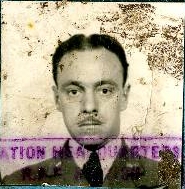 F/Lt (Air Gnr) Francis Charles BARRETT DFC 77959 + |
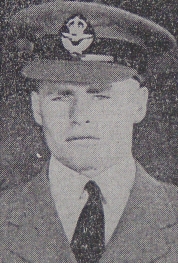 F/O (Pilot) James Robert ANDERSON DFC 79508 |
|
|
|
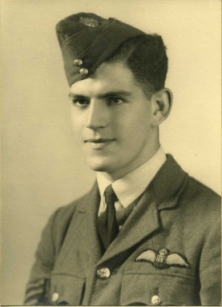 P/O (Pilot) Wilfred Bertrand STEPHENS 113267 + |
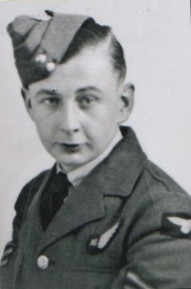 Sgt (WOP/Air Gnr) Thomas Edward PATTISON 644625 |
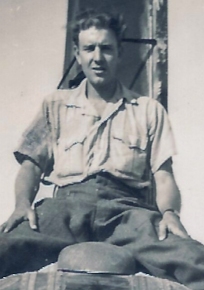 Sgt (WOP/Air Gnr) Sydney Frederick HAYDEN 910905 |
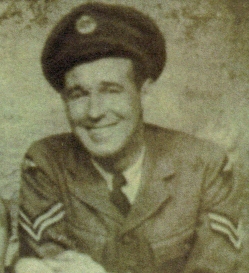 Sgt (Fitter 2E) Andrew McMillan Smith BROWNLIE 546659 + |
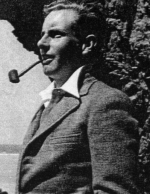 Sgt (WOP/Air Gnr) Walter Paul BROOKS 931402 + |
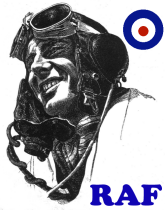 F/Sgt (Pilot) George BUCHANAN 1060536 + |
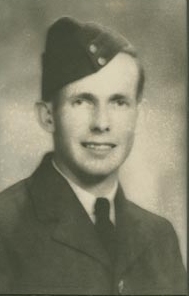 F/Sgt (Obs/Nav) Carlton Stokes GOODENOUGH R/62738 + RCAF |
 F/Sgt (Obs/Nav) Leslie George JORDAN 905148 + |
P/O (Obs/Nav) George Frederick KING J/15525 RCAF + |
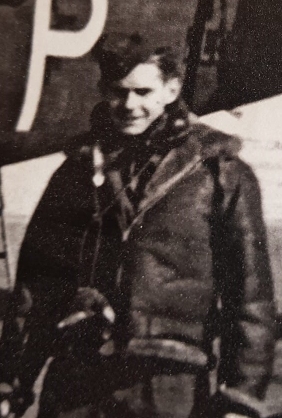 F/Sgt (Pilot) Herbert William Thornley SLOMAN 402677 + RAAF |
- |
Jim Anderson the son of J R Anderson was so kind to send on many photos from his fathers collection including this one below of a 108 Squadron football team.
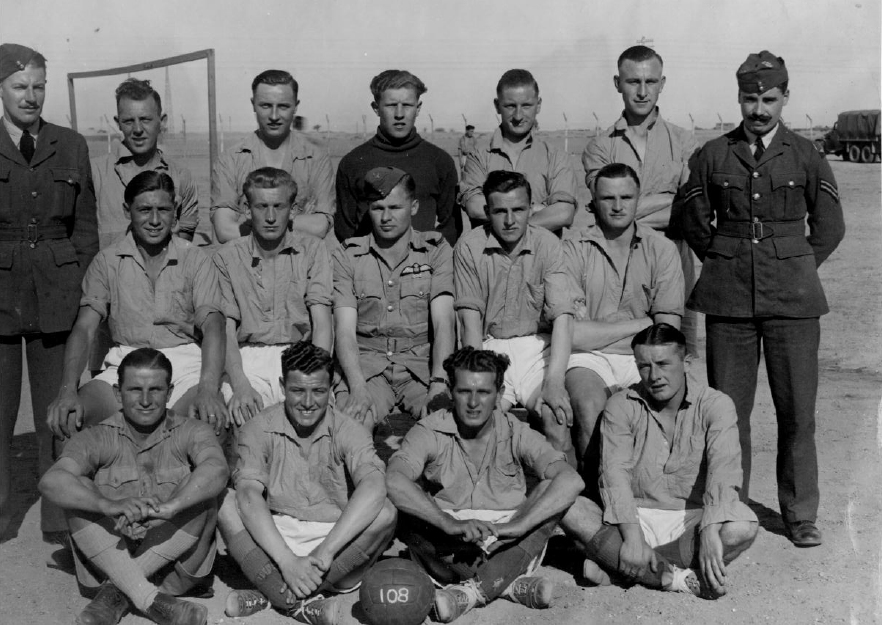
J R Anderson is seated in the middle of the of the above group, his pilot's wings badge visible on his chest, and the DFC award below that. James Anderson came from New Zealand and had trained with the Royal New Zealand Air Force prior to transferring to the RAF. He began his wartime career with 40 Squadron of the RAF, piloting Wellington bombers on raids against targets in Germany and France.
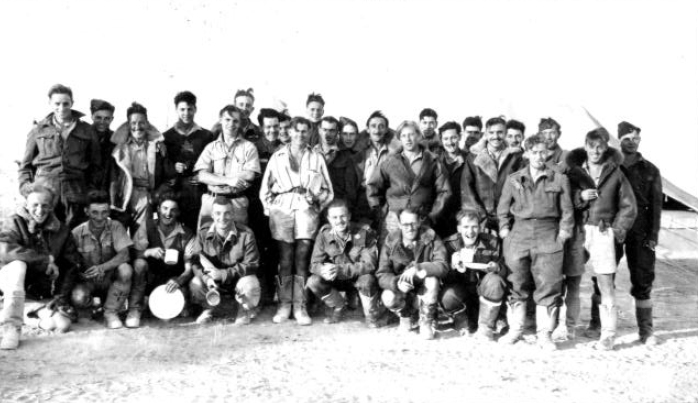
A group photo from Jim Anderson of 108 Squadron airmen, without names recorded. The grandson of the airman on the extreme right of the photo recognized his grandfather, David Fairclough Smith.
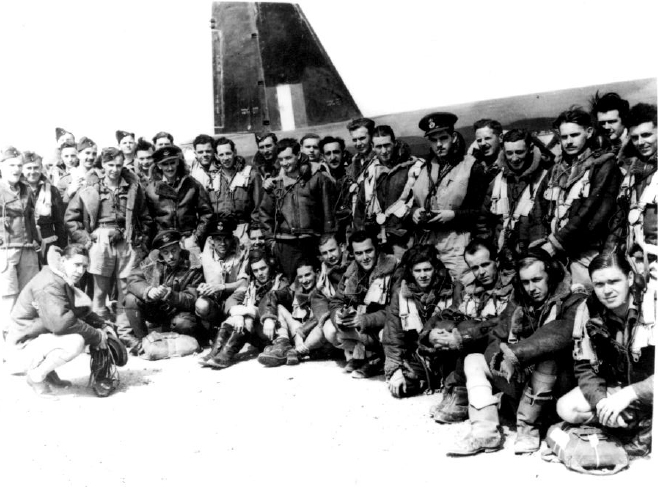
The above photos was supplied by the Anderson and Brooks family and is described as a press photo of 108 Squadron. Identified in this are Walther Brooks standing at the left, wearing shorts and with flight jacket open. Kneeling on the ground in front of him appears to be F C Barrett based on other photos received of him. Compared to the photos that the Pattison family sent, T E Pattison seems to be the sixth airman from the right kneeling.
The remains of the dead airmen were returned to their families
for burial with the exception of the Australian and Canadian
airmen. They were buried in adjacent graves in Belfast City
Cemetery on 21 March 1942.
Richard John Wells was a 28 year old combat experienced
pilot. Son of Richard Alexander and Ada Wells, he was born in
1913 in Yarmouth, Norfolk. His wartime records show
his fathers address to be 48 Mere Street, Diss in Norfolk and
his mother at addresses in Romford, Essex. He had been
commissioned as an RAF officer in 1937 and was posted to the
Middle East. His service career saw him twice awarded the
Distinguished Flying Cross in 1941, first with 148 Squadron and
later with 108 Squadron. Essex newspapers reported in 1941
and 1942 that his parents in Romford and he had attended Beccles
College.
Richard's cousin, Lt(A) Claude G H Richardson, a pilot in the
Royal Navy, Fleet Air Arm, was killed in a Supermarine Walrus
crash in January 1944 in Trinidad and Tobago.
John Tolson came from Harpenden in Hertfordshire. Aged
just 21, he was co-pilot on this flight. John's father died only
a year after him and both son and father lie side by side in
adjacent graves. John's brother and family members came to
County Louth in 2002 and met some former members of the Irish
Army who had attended the crash site, along with local witnesses
and some who were raising a memorial to the lost crew men.
Members of John's family have been active in remembering John's
service and death. This short documentary was created by his
nephew to tell the story of John, Paul Morey and commemoration
efforts in Louth.
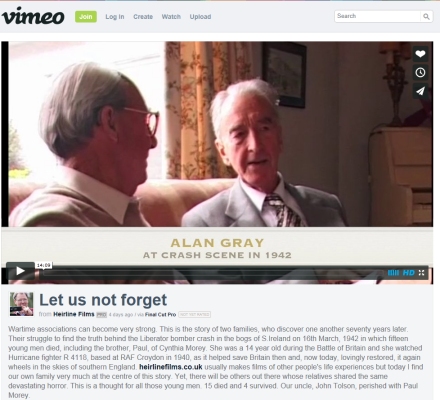 Let us not
forget from Heirline
Films on Vimeo.
Let us not
forget from Heirline
Films on Vimeo.
John's relative returned again in 2022 to view the new memorial
raised at the site.
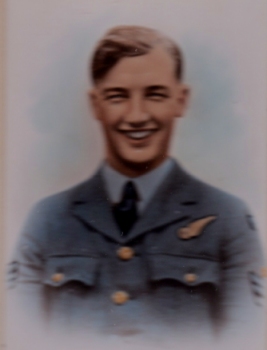 Paul H
Morey was a 22 year old navigator from Leamington Spa. His
sister Cynthia wrote a book about her family and the death of
her older brother. That book included some of the details she
had obtained from Steve Challen in the 1990's. The book is
titled - 'Dark is the Dawn' and was published in 2009. T
E Pattison one of the survivors wrote to Paul's father after the
crash to tell what had happened and to pass on his memories of
Paul. Similarly the new commander of 108 Squadron also wrote to
the family to tell of his devotion to service and skills.
Paul H
Morey was a 22 year old navigator from Leamington Spa. His
sister Cynthia wrote a book about her family and the death of
her older brother. That book included some of the details she
had obtained from Steve Challen in the 1990's. The book is
titled - 'Dark is the Dawn' and was published in 2009. T
E Pattison one of the survivors wrote to Paul's father after the
crash to tell what had happened and to pass on his memories of
Paul. Similarly the new commander of 108 Squadron also wrote to
the family to tell of his devotion to service and skills.
Henry James Gibbons was the son of Herbert F. J. Gibbons
and Lilian E. Gibbons, of 9 Coleridge Road, Newport, just 20
years old at the time of his death. The 1939 register
finds him living at the above address with his parents and
employed as a railway clerk in the Docks Section. His
father also worked on the railways, as a freight train
controller.
He was an air gunner and wireless operator from the squadron.
In correspondence with former residents of his parents home, it
was learned that Henry was an only child and his photo rested on
the mantle of his parents house until their deaths, both in
1968, within a month of one another. No relatives were found in
the Newport area and it appears that his father, a railway
clerk, was born in Gloucester.
His name is recorded on war memorials in his native Newport, but
beyond that, little remains of Henry's memory it seems.
Charles Joseph Ingram was buried in West Ham cemetery
in London. His CWGC entry contains no next of kin details but
his death registration in Ireland gives his age as 24 years and
there is a corresponding birth registered in West Ham district
in 1918. His parents, Agnes and Charles W Ingram had married in
1914 and in 1942 lived at 10 Lincoln Road in Plaistow. The photo
of Charles above is a cropped image from the WW2
images collection. Charles is found on the 1939
register living with his parents and two sisters at Trinity St,
West Ham. He lists an occupation of Chartered Patents
Agents Clerk.
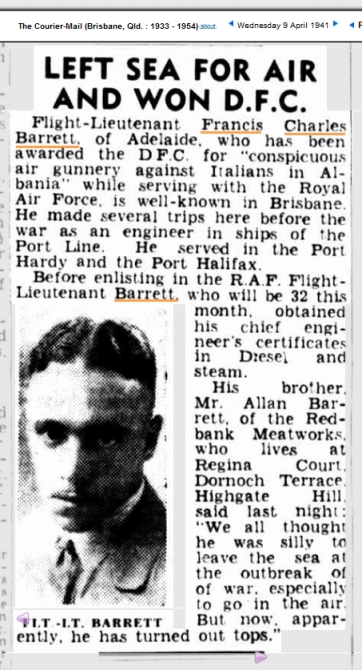 "Francis
C Barrett was a an Australian born officer serving in the
Royal Air Force. Son of Alice Ida and Francis James Barrett from
South Australia, Francis had been awarded the Distinguished
Flying Cross in April 1941 for his service with 70 Squadron.
This squadron had served in the Middle East from the very start
of the war. Australian newspapers carried the story behind the
awards, his conspicuous service during 1941 including over
Albania. The Advertiser of Adelaide, published:
"Francis
C Barrett was a an Australian born officer serving in the
Royal Air Force. Son of Alice Ida and Francis James Barrett from
South Australia, Francis had been awarded the Distinguished
Flying Cross in April 1941 for his service with 70 Squadron.
This squadron had served in the Middle East from the very start
of the war. Australian newspapers carried the story behind the
awards, his conspicuous service during 1941 including over
Albania. The Advertiser of Adelaide, published:
Flight-Lieutenant Barrett is the senior air gunner of the
R.A.F. squadron serving with the Near East Command. He has
earned a reputation as a first-class shot, and instructor. he
took part in a successful daylight bombing raid over Vlona,
Albania and it was chiefly due to his firing accuracy that
attacking Italian aircraft were driven off. One enemy plane
engaged in a counter attack was shot down by Flight-Lieutenant
Barrett.
Being an Australian meant that F/Lt Barrett was interred in the
Cemetery in Belfast with the other four overseas airmen. The
Barrett family would suffer further during the war as his
brother Allen Bernard was also killed in 1945 with Bomber
Command. He is buried in Germany. The men's mother had passed
away before the war in 1925. The newspaper article at left was
published with photo in the The Courier-Mail in Brisbane in
April 1941. In March 1942, South Australian newspaper carried a
memoriam notice for Francis apparently from a fiancee named
Nancy. Another March article published:
Mr. and Mrs. W. Beames, of Main avenue,
Frewville, have been informed that their nephew,
Flight-Lieut. F. C. Barrett, DFC, was killed on March 16
while on a transit flight in Jenkinstown, Kilkeney, Eire. He
joined the RAF in England, and was awarded for the DFC for
exceptional accuracy and daring in shooting down Italian
planes in Albania. Flight-Lieutenant Barrett attended
Pulteney Grammar School, and served an apprenticeship with
Herron Engineering. Co. Later he was an engineer at sea,
before joining the RAF. He was 32.
James Anderson was born in Lyttelton, New Zealand. His
father passed away when he was young. Finishing school he first
worked as an Electrical Fitter in the Electrical Supply
Department and later the Public Works Department in Addington.
He enlisted in the Royal New Zealand Air Force in October 1939
and after graduating was posted to the United Kingdom and
received a commission in the Royal Air Force. Joining the RAF's
103 Squadron he piloted Wellington bombers on the early raids
against targets in France and Germany. His earliest combat
missions were two on the single engined Battle bomber during
September 1940 followed by raids as second pilot of Wellingtons.
In April of 1941 he became the captain of his own aircraft in
raids against the French port of Brest in the RAF's efforts to
destroy the German warships the the Scharnhorst and Gneisenhau.
It was for his actions during another raid on Brest on June
13/14th 1941 that he was awarded his first Distinguished Flying
Cross (DFC). This raid was delivered at low level against dock
buildings. Upon arriving at the target P/O Anderson circled the
area in Wellington R1588 until visibility allowed him to bomb
the target. His name was published in the London Gazette in July
1941 and his home newspapers carried the citation and his photo
that summer. At the beginning of July 1941 he transferred to the
Middle East and undertook the dangerous Ferry flight in a
Wellington from Portreath in Cornwall, to Gibralter, and thence
across the Mediterranean to Malta and then to Egypt. There he
joined 108 Squadron flying Wellington bombers and was awarded a
bar to the previous DFC when he brought home his crew in the
damaged Wellington T2832 on October 23rd, 1941. Sgt's C R Amos
and G R King appear to have been with him on that flight. With
damage preventing the landing gear from being lowered, four crew
members bailed out of the aircraft in friendly territory and P/O
Anderson had to bring the bomber in for a crash landing in the
desert. After recovering as best he could from his injuries,
after the crash, from Aug 1943 until June 1944, he flew
non-operationally with No.1 Radio School, mainly in Proctors.
From July to September 1944 he flew non-operationally with No.42
O.T.U No. 38 Group, mainly in Whitley bombers. Jim Anderson
corresponded with Steve Challen after the war and his son Jim
also provided copies of his flying log book and letters he wrote
from hospital. He was terribly burnt about his legs in the
crash, he recalled coming around after the crash and discovering
he was standing in flames. His injuries stayed with him for the
rest of his life, requiring dressing for many years. Despite
this and having a leg amputated in 1979, he took part in the
tragic Fastnet Race in the same year.
His log book records this fateful flight.

He wrote the following in a letter to his mother in August
1942: Well, there is nothing
much to tell about what happened. I was a passenger
and we left the day before to do it in one hop in one of our
new kites, we were to stay for a while and then take
others back. We had cloud for a long time and then
saw lights and knew we were O.K. Everybody in the back
relaxed and we lay down again. Dawn was breaking and
with a few streaks appearing in the clouds we thought
everything was lovely and all of a sudden we went
into some cloud and we saw the top of a hill go under
the escape hatch. Everybody grabbed for something and
in a split second we hit. I was lying on the bottom
of the machine bracing myself by the hands against a
piece of armour plating. When I came to the fuselage
was empty except for a pair of legs sticking out of the
tail. Apparently I must have bent in the
middle when we hit and banged my head on the armour
as I had quite a dent in my forehead together with a cut on
the chin and a piece off my left ear. At any rate
I was pretty badly concussed and have but very confused
memories of the happenings afterwards. The fog
lifted in the afternoon and we were found by the Ambulance
at about 3.30 in the afternoon.
According to what a couple of the others and myself
have pieced together the wing must have caught fire
later on. I can remember going toward it for some
reason or other and from the burns, I must have stood in
the burning wreckage. I can remember tying an old piece old
piece of dressing gown round my legs and then
wandering out when the Red Cross arrived. I was
still getting round quite well and when we got to Hospital I
thought I’d be able to get out in a tew days
after my legs had been dressed. After two days,
two of us were sent over to the workhouse at Daisy Hill
where I stayed for a fortnight. The other fellow only had
bruises and shock and went home after a week.
Cyril Rowland Amos was born in 1917 to Elsie and Harry
Amos, his father being a British merchant who lived in Argentina
between the wars.
Cyril remained in Hospital in Dundalk until the 19th of March
and was then sent across the border with Sgt Hayden. Having
survived the crash of AL577, Sgt Amos was posted as an
instructor to 22 Operational Training Unit between October and
December 1942.
He was commissioned as an officer in the RAF during the winter of 1942 and returned to flying duties. Cyril's luck ran out on December 31st 1943, only days after arriving with the training unit, when as pilot of Wellington X9666 from 21 Operational Training Unit he crashed into Ffrith Caenewydd, above Aberdovey, Merioneth in bad weather. Cyril died from his injuries shortly after this crash, which also killed two other airmen and injured two others. Cyril was buried in Tywyn Cemetery in Wales. His brother Harry was a wartime pilot also.
Lindsay Ross Williams was a New South Wales born pilot
from the Royal Australian Air Force. He was the son of Henry
Stanley and Elsie Ethel Mary Williams, of Five Dock, New South
Wales and born in 1915. Like many of the others, he had been
sent to Canada for training, being posted to the UK in 1941. He
served briefly with 11 OTU and 142 Squadron before transferring
to the Middle East in September 1941 after which he was posted
to 108 Squadron. He was 26 years of age at the time of his death
and before the war had been a farmer. Remembrance notices
in papers were posted by his mother and a fiance, Marriane
Warner.
Wilfred Bertrand Stephens, one of the pilot passengers on the aircraft came from Westminster, London. His Commonwealth War Graves Commission entry show that his remains were returned to Mill Hill Cemetery in the City. No next of kin is listed for him but the telegrams in Australian records indicate that his mother Mrs Stephens lived at 213 Watford Way, Hendon. His parents, Eleanor Larkman and Bertrand William Stephans married in 1921 and Wilfred was their only son as the inscription on his grave relates. His father was a veteran of home service with the Tank Corps in the First World War. It is not clear but his father had remarried in 1936 so Wilfred's mother may have passed away or separated from B W Stephens.
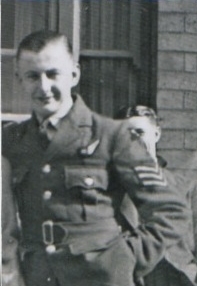 Thomas
Edward Pattison was a Durham born Wireless Operator/Air
Gunner flying as a passenger on AL577. At the time of the crash,
his parents lived in Highfield, Leicester. Tom Pattison
after his recovery had the unenviable task of contacting some of
his dead comrades families to let them know a little more about
their loved ones and their demise. Royal Air Force records show
that many of the families were written to and sent a stamped
addressed envelope to allow them contact Thomas. He wrote
to the Morey family in particular and in later life he was in
correspondence with Steve Challen in his research. An
extract of the letter to the Morey family can be found further
up the page. Tom married after the war but did not have
children. He passed away in Leicester in 1997. His sisters were
kind enough to contact in 2013 and pass on his photos.
Thomas
Edward Pattison was a Durham born Wireless Operator/Air
Gunner flying as a passenger on AL577. At the time of the crash,
his parents lived in Highfield, Leicester. Tom Pattison
after his recovery had the unenviable task of contacting some of
his dead comrades families to let them know a little more about
their loved ones and their demise. Royal Air Force records show
that many of the families were written to and sent a stamped
addressed envelope to allow them contact Thomas. He wrote
to the Morey family in particular and in later life he was in
correspondence with Steve Challen in his research. An
extract of the letter to the Morey family can be found further
up the page. Tom married after the war but did not have
children. He passed away in Leicester in 1997. His sisters were
kind enough to contact in 2013 and pass on his photos.
Sydney Frederick Hayden was another of the Australians on
board AL577 and like F/Lt Barrett, a member of the Royal Air
Force, rather than the Royal Australian Air Force. Sgt
Hayden had been born in 1920 in England and one year later
sailed with his mother Charlotte and older brother to Australia
where the family lived. His mother was Australian, as was
his bother Cecil, four years older than Sydney.
Sgt Hayden was badly injured in the crash, ending up
unconscious and with severe leg fractures. He was treated in
Newry and Stranmillis Hospital, Belfast for his injuries while
his father in Australia received messages advising him first
that his son was severely injured and interned in Eire. Further
telegrams over the following weeks would pass on the welcome
news that he was recovering and he was removed from 'dangerously
ill lists' on the 1st of May.
Such were his injuries, after further treatment, Sgt Hayden
returned to Australia in July 1943.
The address of his father, Sidney William Hayden, was given at
the General Electric Company in Sydney, Australia. Steve
Challen managed to make contact with Sydney Hayden in the 1980's
or 90's but it appears that he did not wish to discuss his
wartime experiences.
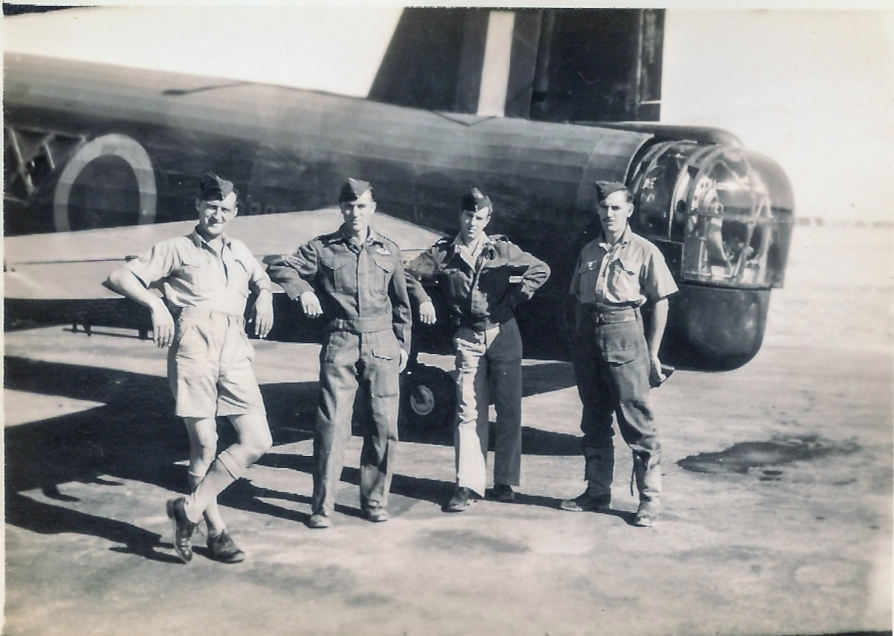
In the photo above, Sidney Hayden appears second from the right with three unknown comrades.
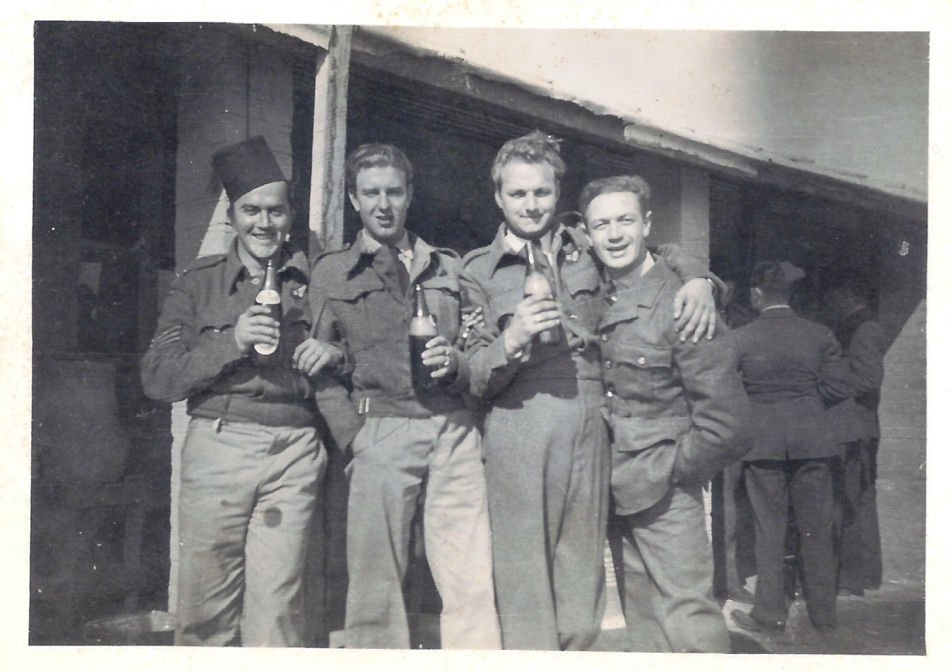
Sidney only died in 2005 and his grand daughter was so very kind to supply a great number of photo's of Sidney both before and after the crash. As discovered by Steve Challen, Sidney certainly never spoke much of his wartime experience with family either. They themselves were only too aware of his injuries that resulted in him walking with the aid of leg calipers even up to the 1960's and with crutches after that.
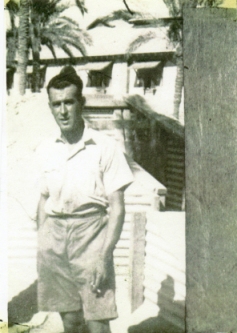 Andrew
Brownlie was a 29 year old aircraft fitter from Glasgow.
His great nephew was kind enough to provide the photos included
with this article. Among the photos was the one at left with him
in a distinctly tropical setting. Andrew was the only passenger
on the aircraft who was not aircrew, in that he would not have
flown combat missions while in North Africa. War Graves records
show that his trade was that of Fitter II (E). His sister was
100 years old in 2009. Their parents were Thomas and Marion
Brownlie.
Andrew
Brownlie was a 29 year old aircraft fitter from Glasgow.
His great nephew was kind enough to provide the photos included
with this article. Among the photos was the one at left with him
in a distinctly tropical setting. Andrew was the only passenger
on the aircraft who was not aircrew, in that he would not have
flown combat missions while in North Africa. War Graves records
show that his trade was that of Fitter II (E). His sister was
100 years old in 2009. Their parents were Thomas and Marion
Brownlie.
Walter P Brooks was just 20 years old and the son of Mabel and Walter Horace Harry Brooks. Walter was born in Wandsworth, London in 1921. His father passed away in 1944 in Leeds where he was living in 1942. Walter's brother was kind enough to send the photo of him.
George Buchanan was the son of Helen and William Buchanan and was from Paisley in Scotland. His parents lived at 14 Howe St in the town. Like many of the dead from AL577 he was returned to his parents for burial. F/Sgt Buchanan was another of the pilots destined for the UK and the collection of new Liberators.
Carlton S Goodenough was a 28 year old navigator passenger on the aircraft. The son of Wright E. and Eva Stokes Goodenough from Bury, Quebec. Carlton was a teacher of seven years experience. He married his wife, Margaret Bagley in 1937 and a son, Thomas was born the following year. Carlton enlisted in July 1940, and had arrived in the UK in April 1941. F/Sgt Goodenough was interred in Belfast City Cemetery. His photo on this page was found on the McGill University memorial website on his individual page. His son Thomas passed away in 2005.
Leslie George Jordan was 20 years old and the son of
John B. Jordan and Rose Jordan, of Portslade. He is found
residing with his parents at 235 Old Shoreham Road in Portslade
on the 1939 register. On that, he is listed as being a
scholar but also being a member of 226 Battery, of the Royal
Artillery. Leslies's father was a veteran of the First
World War
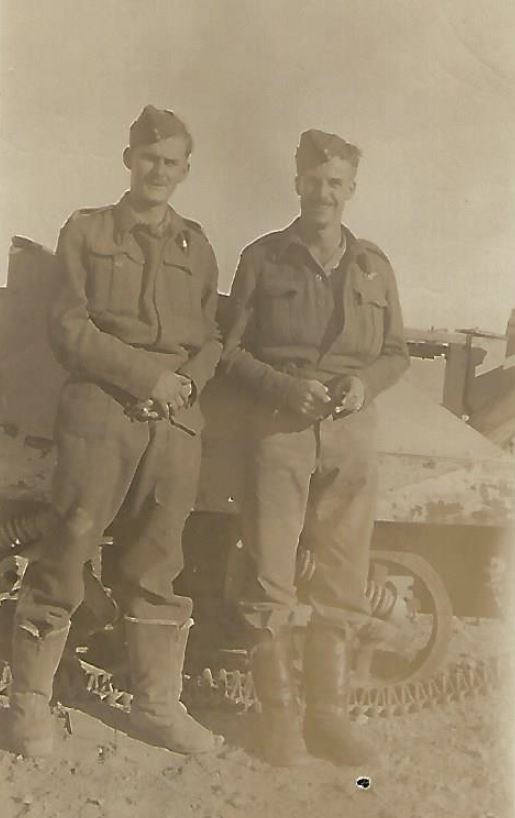 George Frederick King,
one of two Canadians on the aircraft came from Ontario. The 25
year old King, the son of Philip and Belinda King, had engaged
in some flying before enlistment in April 1940, leaving his job
in New Toronto with the Campbell Soup Co. He arrived in the
United Kingdom in November 1940 after training in Canada. His
first service posting was with 103 Squadron from March 1941 as
an Observer, or navigator. He was later again posted to the
Middle East and his service file indicates he joined 108
Squadron in August 1941. K F Vare the officer who had to take
over 108 Squadron from the deceased W/Cdr Wells wrote to
George's mother after his death: "Your
son had been with the Squadron since 6th August, 1942, and
had made twenty-nine raids against the enemy. His Flight
Commander has always spoken well of his work. His zeal for
operations were remarkable and we all, here, feel it very
strongly that he has gone." Sgt King was buried
on 21st March at Belfast City Cemetery, alongside his comrades.
George Frederick King,
one of two Canadians on the aircraft came from Ontario. The 25
year old King, the son of Philip and Belinda King, had engaged
in some flying before enlistment in April 1940, leaving his job
in New Toronto with the Campbell Soup Co. He arrived in the
United Kingdom in November 1940 after training in Canada. His
first service posting was with 103 Squadron from March 1941 as
an Observer, or navigator. He was later again posted to the
Middle East and his service file indicates he joined 108
Squadron in August 1941. K F Vare the officer who had to take
over 108 Squadron from the deceased W/Cdr Wells wrote to
George's mother after his death: "Your
son had been with the Squadron since 6th August, 1942, and
had made twenty-nine raids against the enemy. His Flight
Commander has always spoken well of his work. His zeal for
operations were remarkable and we all, here, feel it very
strongly that he has gone." Sgt King was buried
on 21st March at Belfast City Cemetery, alongside his comrades.
The photo at left was provided by his niece and shows George
standing at the right with a colleague named George Kusiar.
The Toronto Star on the 19th of March 1942 reported on his
death having been notified to his parents:
New Toronto, March 19-Flight-Sergeant
George F. King, son of Mr. and Mrs. Philip King 5th St., New
Toronto, lost his life in action near Dundalk, Eire, on
March 16, according to a cable received by his parents this
morning.
"I don't quite understand it." said Mr. King.
"George sent us a cable from another front just last week. I
don't see how he could get into action in Ireland so
soon."
Flight-Sergeant King joined the R.C.A.F. shortly after the
declaration of war and had been overseas more than two
years. He was one of the first observers to graduate from
Malton air school.
He was born in Toronto 24 years ago. He was a graduate
of Mimico high school where he established a fine athletic
record. He is survived by his mother and father and two
sisters, Mrs. Lorne Sones of Mimico and Greta Muriel King,
who lives at home.
Herbert W T Sloman came from New South Wales, the only son
of Mary Alice and George Sloman. He enlisted in September 1940
and embarked for Canada in January 1941 where he trained as a
pilot with 7 Service Flying Training School at Fort MacLeod,
Alberta. While there, near the end of his training, he was
lucky to survive a night time landing in Avro Anson, serial
number 1817. The aircraft swung on landing, ground looped
and was badly damaged. Herbert was somehow not injured and
received a reprimand for his landing. He graduated in
Course 22 on the 5th of May 1941. From there he shipped
out to the United Kingdom arriving in June 1941. After further
crew training in the UK at 20 OTU, he was posted to 40 Squadron
at Harwell. He was posted to the Middle East in October
1941, joining 108 Squadron in November. He was buried on March
21st in Belfast. Herbert had three sisters surviving him.
On the same day as the crash of Liberator AL577, only a few
miles north in Northern Ireland, another RAF aircraft, this time
Vickers Wellington X3599 from 57 Squadron crashed in the hills
above Newcastle, killing five men. Two members of this
crew, along with five of the crew of AL577, Barrett, Goodenough,
King, Sloman and Williams were buried on the 21 March 1942 in
Belfast City cemetery. Canadian newspapers reported on
this in particular due to there being three RCAF members between
the two aircraft.
The crash site, shown in the 1942 photo at the start of this
article, has been marked by memorials at the site since
1993.
This panorama photo of the site from the lower slopes of
Slievenaglogh shows Annaloughan Mountain in the right background
and some high points to the right.
The incident was raised in the United Kingdom Parliament by
Ralph Glyn, the representative for XXXX. In this he asked
Sir Ralph Glyn, - To ask the Secretary
of State for Air, whether an enquiry was held into the crash
of a Liberator aircraft on the 16th March last at
Jenkinstown, Dundalk, Eire, whilst on passage to this
country from the Middle East; how many lives wore lost and
how many persons injured; whether he is aware that the
relatives of the dead have been unable to recover the
personal effects carried by the deceased officers and men;
what became of other material being conveyed in the
aircraft; and what was the cause of the accident.
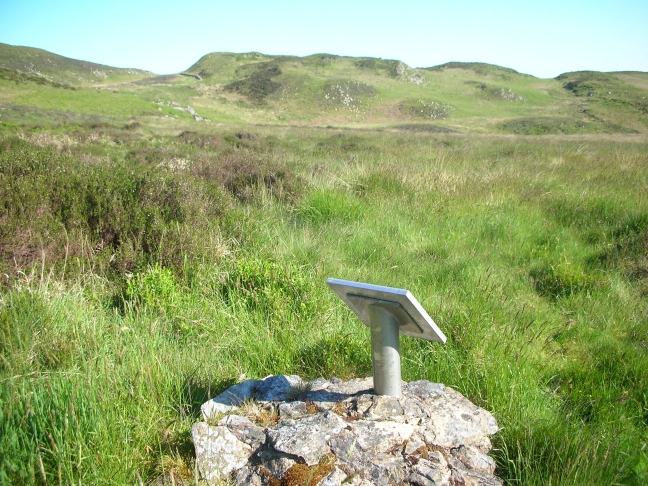
 In 1993, local people from
Louth including Noel Roddy raised the memorial plaque near the
spot. The site is a short walk off a road and not easy to access
due to the condition of ground etc. From the heights above the
crash site one can on a very clear day see down the the east
coast and see the peak of the Sugar Loaf Hill in Wicklow, south
of Dublin city. The memorial plaque for AL577 with the crash
location in the background, in the dip below the lumps on the
hill.
In 1993, local people from
Louth including Noel Roddy raised the memorial plaque near the
spot. The site is a short walk off a road and not easy to access
due to the condition of ground etc. From the heights above the
crash site one can on a very clear day see down the the east
coast and see the peak of the Sugar Loaf Hill in Wicklow, south
of Dublin city. The memorial plaque for AL577 with the crash
location in the background, in the dip below the lumps on the
hill.
 A new memorial was raised at the
site in the 2000's and funnily enough, used the names list from
this site. This memorial plate later had a die cast metal
model of a Liberator in Coastal Command colours. This
memorial was located close to the location of a sizeable patch
of ground that even in May 2022 was largely devoid of
vegetation. Close inspection of that patch of ground
reveals hundreds of tiny green/blue strands of corroded copper
wire, both single strand and braided types. Various items
of broken glass or perspex can also be seen glinting in the sun
and screws and washers can still be found. Adjacent to
that patch of ground is a rock on which locals had painted a
cross in the earliest form of memorial.
A new memorial was raised at the
site in the 2000's and funnily enough, used the names list from
this site. This memorial plate later had a die cast metal
model of a Liberator in Coastal Command colours. This
memorial was located close to the location of a sizeable patch
of ground that even in May 2022 was largely devoid of
vegetation. Close inspection of that patch of ground
reveals hundreds of tiny green/blue strands of corroded copper
wire, both single strand and braided types. Various items
of broken glass or perspex can also be seen glinting in the sun
and screws and washers can still be found. Adjacent to
that patch of ground is a rock on which locals had painted a
cross in the earliest form of memorial.
In March of 2022, to mark the 80th anniversary of the crash,
Noel Roddy's son, Derek, with the aid of friends including
Ciaran Gormley and Archie Murphy, raised a new memorial on the
site using a number of parts from the aircraft, as well as a die
cast model of a Liberator. The memorial was overflown on
the 16 March 2022 by the Irish Coast Guard helicopter based at
Dublin airport, call sign Rescue 116.
The memorial sits roughly on the spot where the wreckage of the
tailplane can be seen in the wartime photos. The photos
below were provided by Derek. The memorial has been
orientated such that the table and aircraft are pointing roughly
along the final tragic path of Liberator AL577. Noel Roddy
understood that one engine was found

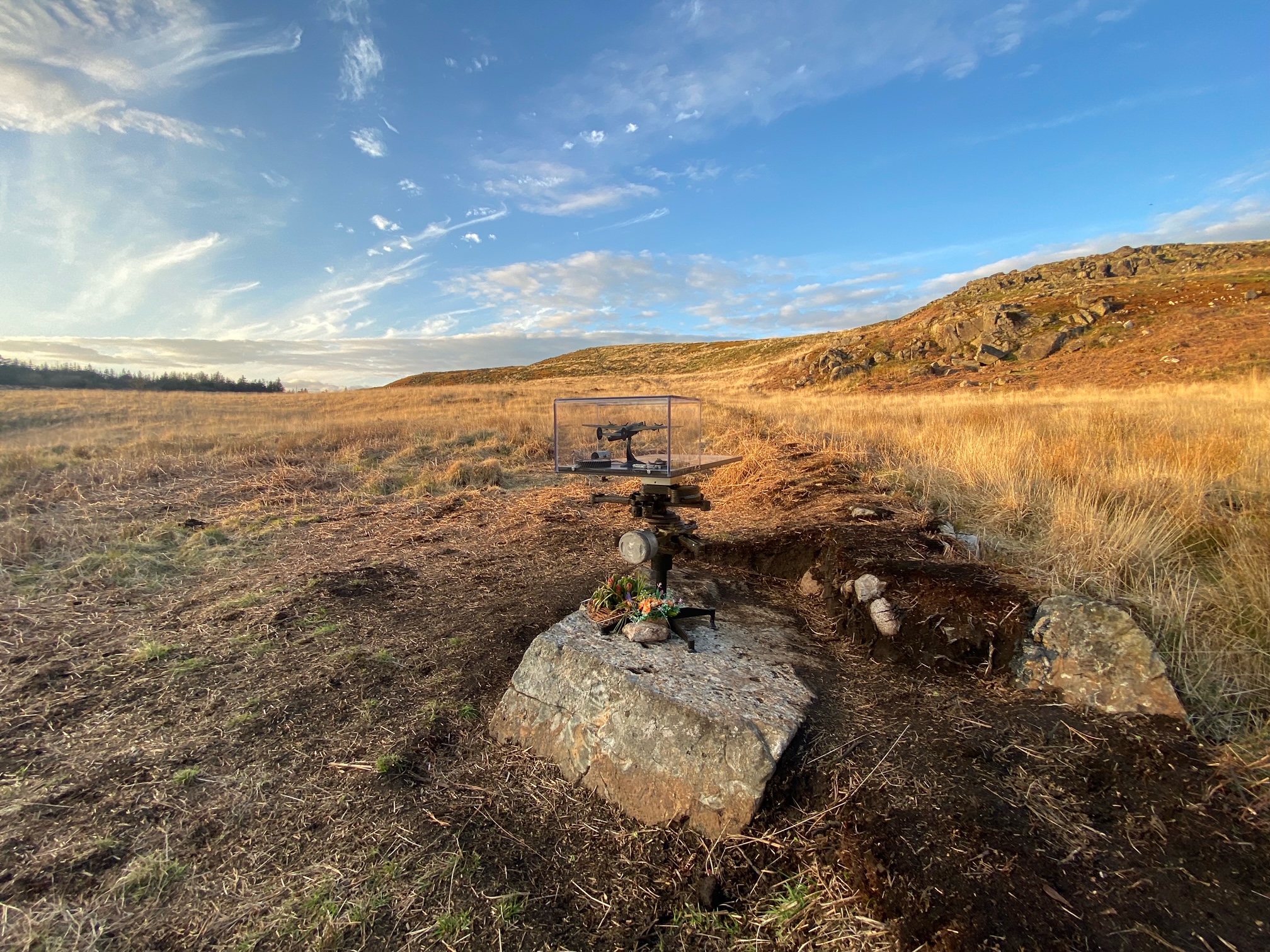
A patch of ground near the rocky outcrop is to this day almost
devoid of vegetation. It is shown beow with the main 2022
memorial in the background.
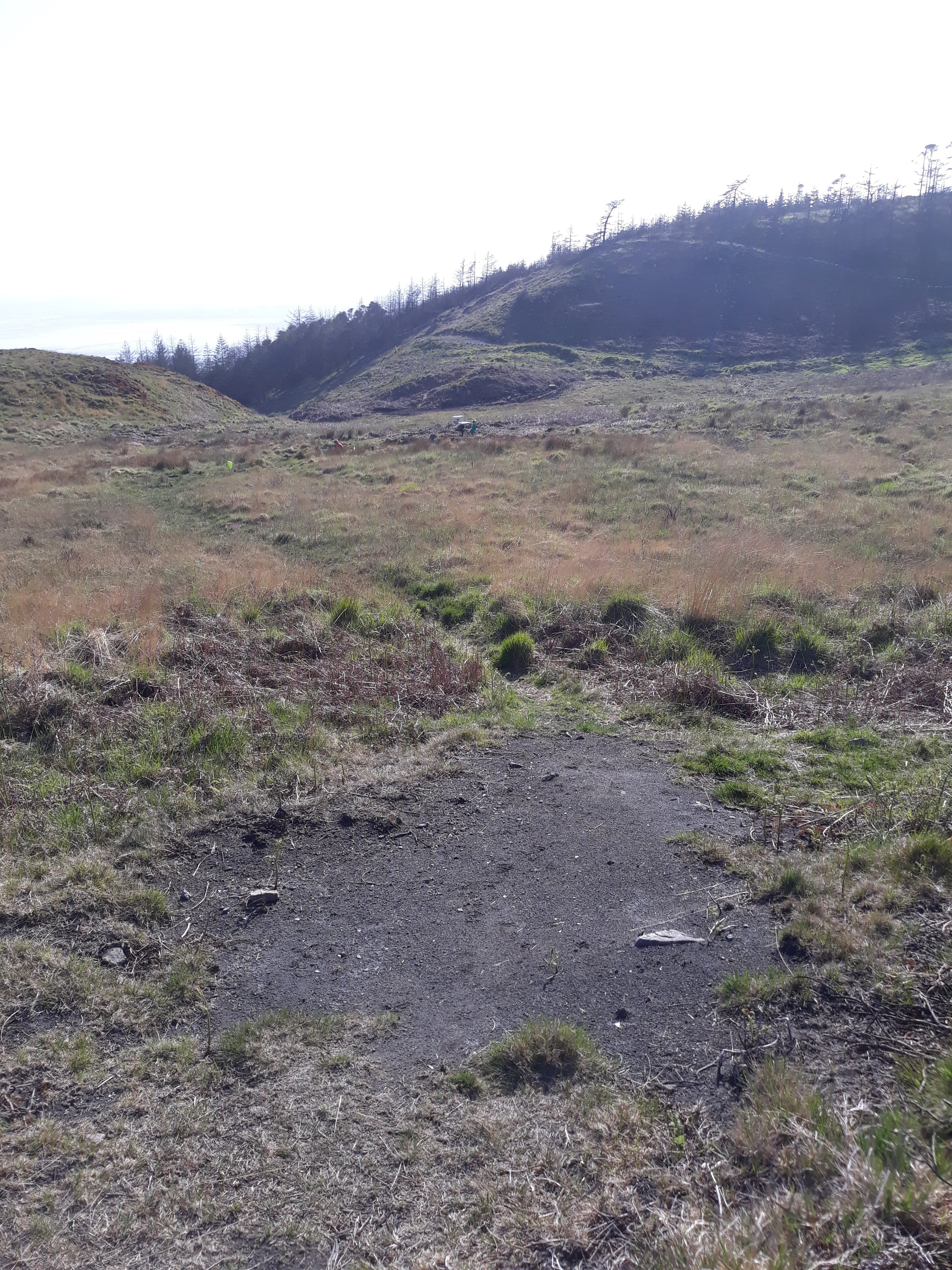
Even a cursory search of this patch will reveal many many
strands of corroded electrical wiring, screws and mall pieces of
aircraft structure. The photo of some of the finds reveals
small screws, pieces of glass or perspex.
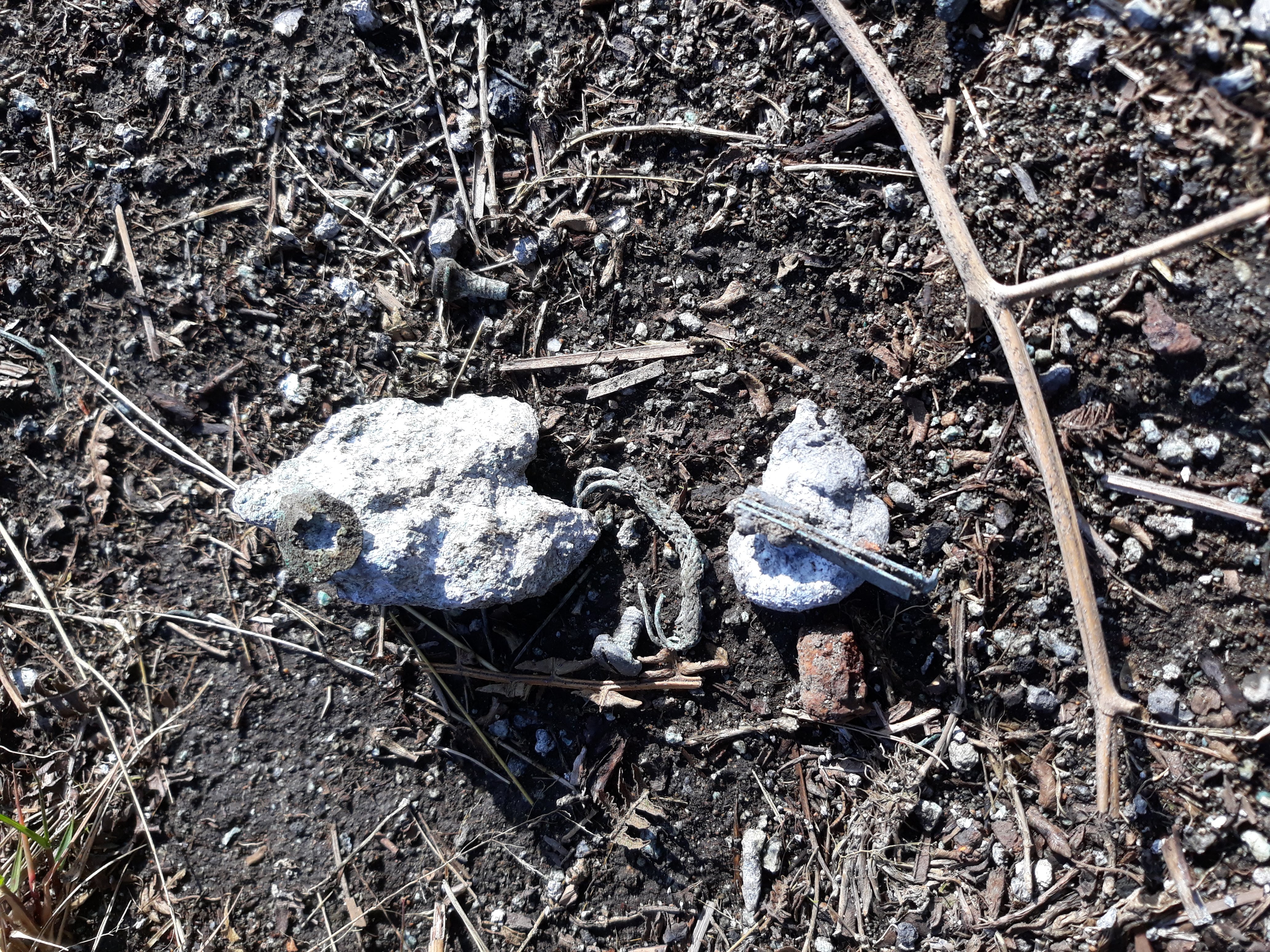
The mountains in this area would claim the destruction of two more aircraft during the war. An RAF Hudson crashed in September 1941 killing 3 men while a P-51 Mustang fighter of the US Army Air Forces crashed in September 1944 killing its pilot.
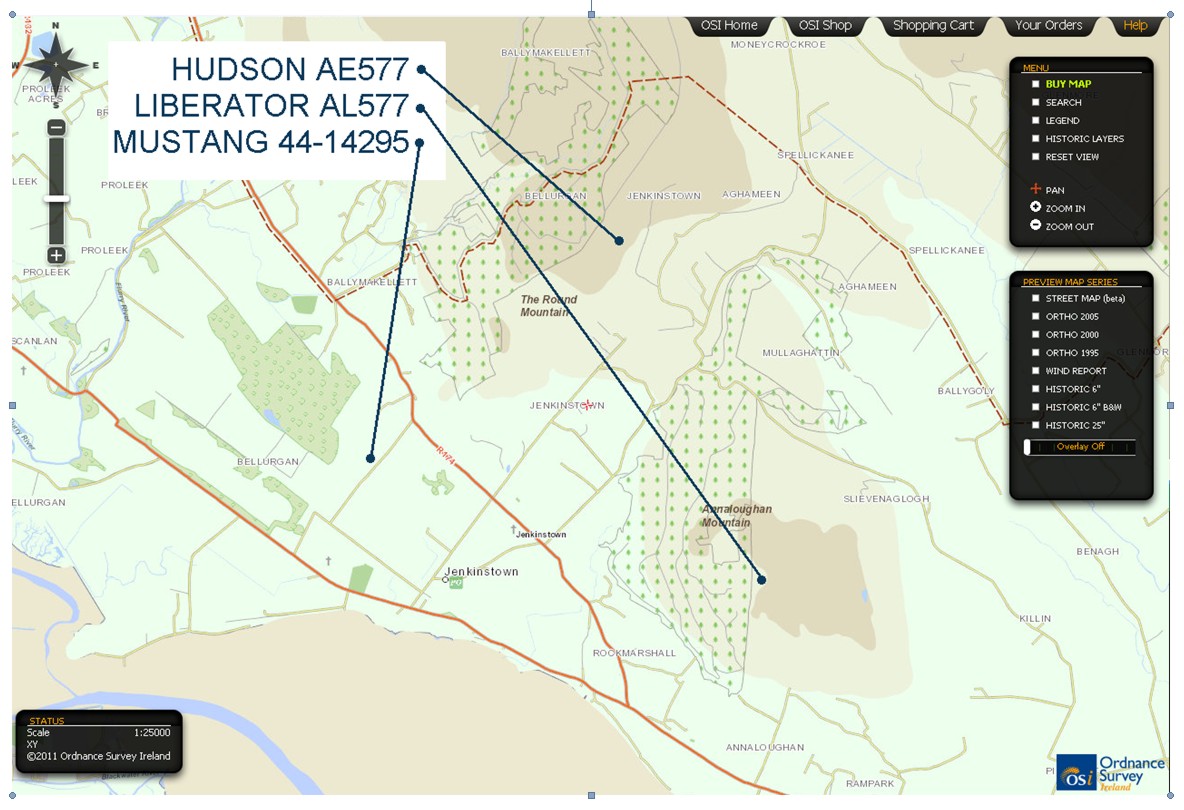
Compiled from various sources by Dennis Burke, Dublin, 2019: Including the Morey, Tolson, Anderson, Pattison, Brownlie and Brooks families. The service records of all Australian and Canadian aircrew members; the Irish Army Archive files in Cathal Brugha Barracks, Dublin; the CWGC. And my friend, Heno, for the use of his photos.

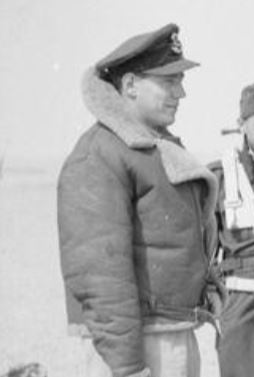 W/Cmdr (Pilot) Richard John WELLS DFC
39918 +
W/Cmdr (Pilot) Richard John WELLS DFC
39918 +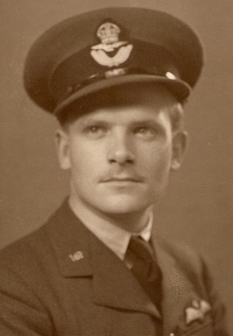 P/O
(Pilot) John Peile TOLSON 67640 +
P/O
(Pilot) John Peile TOLSON 67640 + 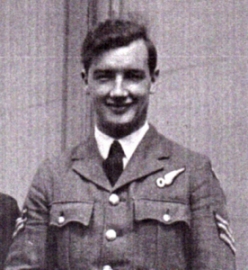 Sgt
(Obs/Nav) Paul Herrick MOREY 917067 +
Sgt
(Obs/Nav) Paul Herrick MOREY 917067 + 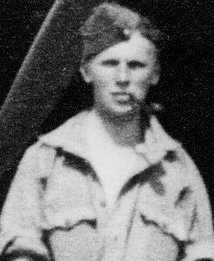 Sgt
(WOP/Air Gnr) Henry James GIBBONS 948393 +
Sgt
(WOP/Air Gnr) Henry James GIBBONS 948393 + 